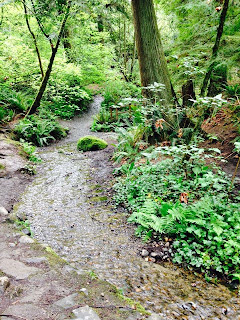Monday, May 4, 2015
Woodland Floor With A Sieve
Using a sieve in nature can be a lot of fun and a great way to really get up close to the smaller elements we so often pass through quickly. Exploring one habitat at a time throughout the year with a sieve is a wonderful way to find those small elements and spend time with them. So, if you focus on different habitats consider adding this tool to your tool box.
My husband assembled a small set of sieves for me to use with our Nature Club. He used some scrap wood and a roll of metal screen to create them. He tried his best to keep them safe for kids by keeping all of the screen folded in, tucked and secure as to not cut little hands. He also braced the corners to help keep them solid as kids aren't always the most gentle of creatures. As well, if one fell while in action we'd like to not have the tool break on them.
I chose a park that offered great choices in forest floor space. It has hills, loads of trees and shrubs, decaying logs and fallen tree debris, a stream, a little waterfall, quite a few trails and open space. As well, we had picnic tables to work with. I ensured there was ample parking for the number of families joining us and was able to let folks know about restroom amenities. I asked families to come prepared for weather, bring nature journals and a pencil (or colored pencils if able), any field guides they might have found to be appropriate for a forest and a magnifying glass or loupe if they own them.
For this activity we broke into small groups and each group then chose which areas they wanted to explore and find places to work with their sieve. The used a cup and their hands to gently scoop up the forest floor and place in the sieve and then a child or team of two worked to gently shake out the debris and dirt. Once it was thinned out then they would take time to see their findings. The process was done about 3-4 times in different areas of the forest for each team. As they discovered great stuff they would bring it down to our work area, picnic tables in the park, and lay them out on an extra sieve. I also had some white paper towels laid out to help the details and colors pop.
Each group tried different types of places among the forest floor such as the base of a tree, under the edge of a decaying log, in piles of decaying leaves, in open areas, under little shrubby plants, near the base of a waterfall, along a stream and near a trail. Different areas certainly offered different results. That in and of itself was a great lesson to discuss. Why some areas produced better results than others.
Once we had all of our findings then we returned to the picnic table as a group and shared our finds. Many families brought along various magnifying glasses and loupes. I also provided several loupes and magnifying glasses to share. I also was able to bring along our stereo-microscope and plug into to our vehicle with an extension cord to use at a table. Kids were having a great time viewing their findings and sharing with each other. Much excitement! We also broke open some field guides to to identify a couple of slugs, a bug and a mushroom. After the fun wore off in sharing and identifying it was time to journal our findings. Each kiddo chose items to observe closer and draw or write about in their nature journals. They are also invited to share their journal work if they choose, which some gladly come right over and share where as others are quite private in their work. All styles of journal work are honored and appreciated.
Tips For This Activity
Choose a dryer spell to get a good forest floor look. If it were to moist you'd have a harder time breaking up the soil or get clumps of debris.
Have teams switch areas to see if results were different, as some have better patience than others.
This would go great following a One Square Foot observation or a Micro Habitat with a decaying log activity.
Small clear containers or jars would be great to place specimens in after they find them. Small flat dishes would work best with a micro scope if you are using one, so that slug slime doesn't end up on your platform.
Labels:
classes,
forest,
forest floor,
hands on learning,
homeschooling,
journals,
kids in nature,
lesson,
loupes,
magnifying glass,
microscope,
Nature Club,
Nature Group,
outdoor groups,
outdoors,
outings,
park,
sieve,
teams
Subscribe to:
Post Comments (Atom)











No comments:
Post a Comment